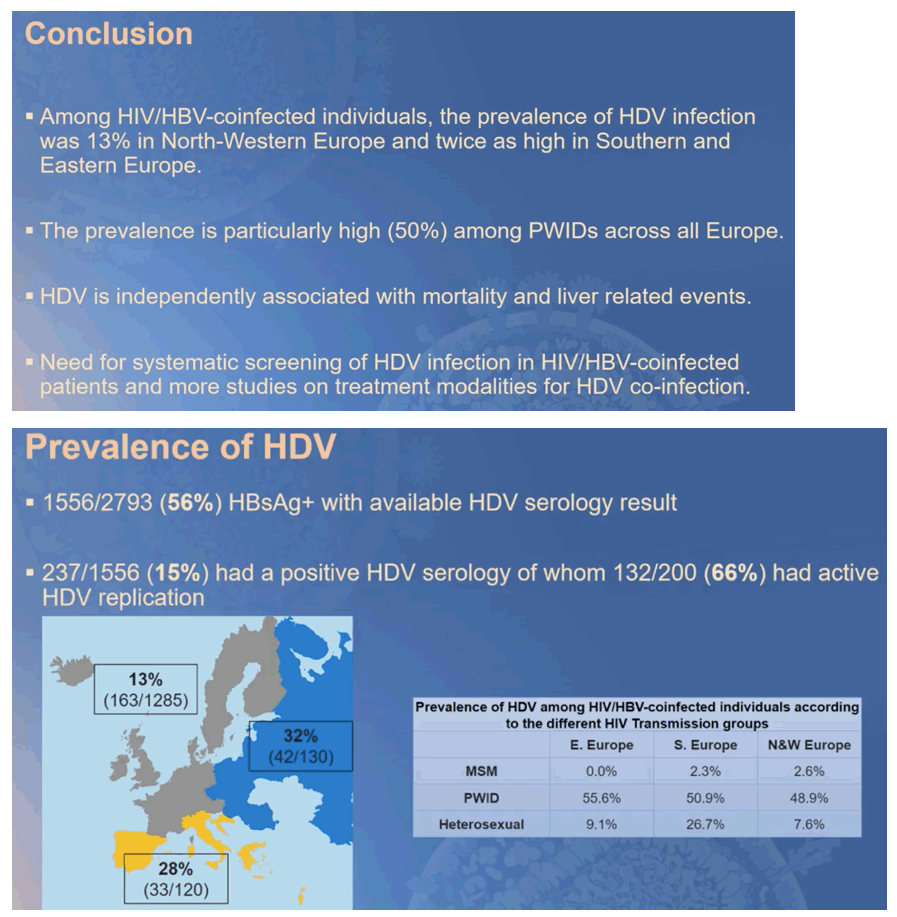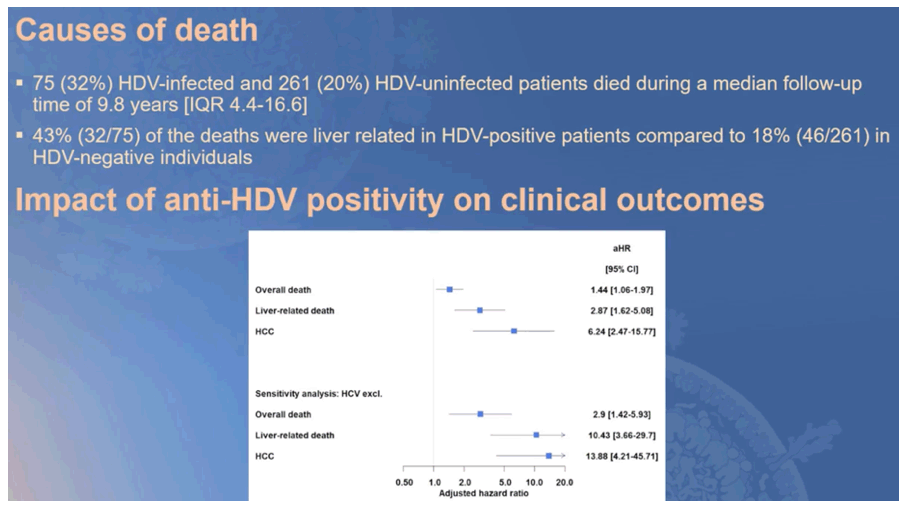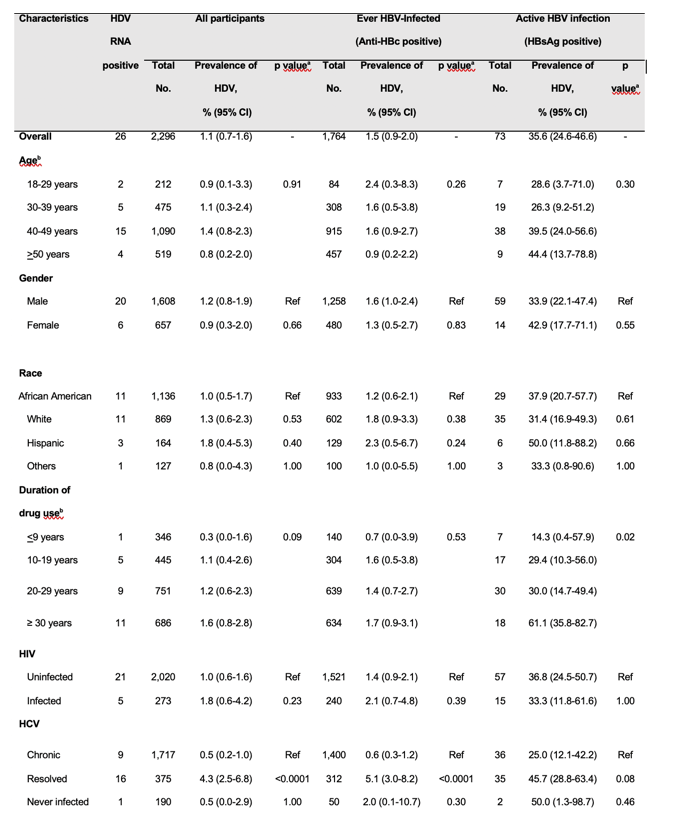| |
High HDV rates Among PWID
|
| |
| |
See below - HDV in SF: Hepatitis D viremia was present in 35.6% of HBsAg-positive participants and was more common in those with resolved compared to chronic hepatitis C - People who inject drugs (PWID) are commonly exposed to hepatitis B virus (HBV) and hepatitis D virus (HDV). We evaluated the prevalence of HDV viremia among hepatitis B surface antigen (HBsAg)-positive.
HDV Among HIV/HBV Coinfected in Europe
in Europe - All PWH with a positive hepatitis B surface antigen (HBsAg) test in the Swiss HIV cohort Study and EuroSIDA were considered and tested for anti-HDV antibodies......Among PWID, the prevalence of HDV co-infection was 49.2%, with similar estimates across the three regions.......The prevalence of HDV co-infection was 15.2% (237/1556, 95% CI: 13.5%-17.1%), of whom 66% (132/200) had active HDV replication......HDV-positive persons were more likely to be persons who inject drugs (PWID) (76.8% vs 14.3%, p<0.001) and to have positive hepatitis C serology (75.5% vs. 24.3%, p<0.001), compared to those without HDV-infection......During a median follow-up time of 9.8 years [IQR 4-4-16.6], seventy-five (31.6%) HDV-positive patients and 261 (19.8%) HDV-negative individuals died. 43% (32/75) of the deaths were liver related in HDV-positive patients compared to 18% (46/261) in HDV-negative individuals. HDV infection was associated with overall mortality (adjusted hazard ratio 1.4; 95% CI 1.1-1.95, p=0.03), liver-related death (2.9, 1.6-5.1, p<0.001) and hepatocellular carcinoma (6.5, 2.6-16.6, p<0.001)

http://www.croiwebcasts.org/console/player/47489?mediaType=slideVideo&


---------------------
HDV in SF: Hepatitis D viremia was present in 35.6% of HBsAg-positive participants and was more common in those with resolved compared to chronic hepatitis C
Testing rates for hepatitis delta in chronic hepatitis B patients in the United States are inappropriately low. Approaches to increase testing for HDV particularly in high-risk subsets should be explored.
HDV seroprevalence global estimates range from 15 million to 72 million people (Figure 1)
In this study of PWID, over a third of participants who were positive for HBsAg also had chronic hepatitis D. Methodologic differences limit comparison of our results to findings from previous studies that examined anti-HDV prevalence [5, 6, 13, 14]; however, our study provides additional evidence that HDV infection is common among HBV-infected PWID in the United States.
Hepatitis D Changing Context Global Prevalence
IVDUs are the group at highest risk of hepatitis D.[21] Most HDV cases are found in IDUs, but the proportion of immigrants is increasing; in the United Kingdom, Germany, and Spain, >70% of the HDV-infected patients born in these countries were IDUs. Among 1319 HBsAg-positive patients in the EuroSIDA study (Soriano et al. 2011), the prevalence of anti-HD was 14.5% and a similar figure has been reported in HIV/HBV subjects in Romania (Ionescu and Mihăescu 2011); in this population, HDV increased the risk of liver-related deaths and the overall mortality.
http://perspectivesinmedicine.cshlp.org/content/5/7/a021576.full
In Europe, the demise of HDV in domestic populations has been offset by new infections introduced by immigrants from areas where HDV remains endemic.[29] The relative proportion of HDV-infected migrants is increasing compared to HDV-infected native populations[30]; migratory flows have interrupted the decline in infections, whose prevalence in HBsAg carriers stabilised in the last decade at 8-10% i n Germany, Italy, Spain and France.[31] The pattern of decreasing domestic and increasing migrant HDV infections is being observed in all high-income countries.32, 33, 34
HDV-positive subjects had higher risks of all-cause mortality. Incidence rates of HCC were 2.9 fold higher in HDV-positive relative to HDV-negative individuals (p = 0.002). In adjusted analyses, HDV was independently associated with HCC (OR 2.1, 95%CI 1.1-3.9).
Supplemental Table 2: Prevalence of HDV viremia among street-recruited people who injected drugs, San Francisco Bay area, 1998-2000, by HBV infection status and selected characteristics.

Hepatitis D Viremia Among Injection Drug Users in San Francisco
The Journal of Infectious Diseases, Volume 217, Issue 12, 15 June 2018
Abstract
People who inject drugs (PWID) are commonly exposed to hepatitis B virus (HBV) and hepatitis D virus (HDV). We evaluated the prevalence of HDV viremia among hepatitis B surface antigen (HBsAg)-positive PWID (n = 73) using a new quantitative microarray antibody capture (Q-MAC) assay, HDV western blot, and HDV RNA. HDV Q-MAC performed well in this cohort: anti-HDV, 100% sensitivity and specificity; HDV viremia, 61.5% sensitivity and 100% specificity. Hepatitis D viremia was present in 35.6% of HBsAg-positive participants and was more common in those with resolved compared to chronic hepatitis C (5.1% vs 0.6%; adjusted odds ratio, 9.80; P < .0001).
Hepatitis D virus (HDV) requires hepatitis B virus (HBV) for its life cycle; people who inject drugs (PWID) are commonly exposed to both viruses [1]. Compared to those with HBV monoinfection, HBV-HDV coinfected individuals experience a more rapid progression to cirrhosis, higher rates of hepatocellular carcinoma, and mortality [1-3]. In the United States, PWID are the group at highest risk of acquiring and transmitting HDV, yet epidemiological data among such individuals are limited and largely based on anti-HDV measurements among individuals with chronic hepatitis B [4-6]. For clinical and public health purposes, the presence of HDV RNA is more relevant, as viremic individuals can transmit the virus and might benefit from antiviral treatment. Furthermore, the prevalence of hepatitis C virus (HCV) infection among PWID is high, therefore triple infection with chronic hepatitis viruses occurs [7, 8] and the relationship between HDV, HBV, and HCV appears to be complex [9].
Among anti-HBc-positive PWID, those with resolved HCV infection were approximately 8-fold more likely to have HDV infection compared to chronic HCV infection (5.1% vs 0.6%, respectively; P < .0001); among actively infected individuals that difference was approximately 2-fold (45.7% vs 25.0%; P = .08).
Viral interaction patterns in the setting of triple hepatitis virus infections are complex. We found that individuals with chronic hepatitis C were much less likely to have HDV viremia and, if HDV RNA was present, the level tended to be lower than among individuals with resolved HCV infection. We also observed lower HBV DNA levels among people with either chronic hepatitis C or chronic hepatitis D. Our study was cross-sectional; therefore, we could not examine the timing of viral acquisition. However, these relationships could have implications for antiviral treatment of chronic hepatitis C. "Interferon-free" HCV regimens based on direct-acting antiviral agents (DAAs) lack the suppressive effect of interferon-α on HBV and HDV. HBV reactivation with fulminant hepatitis has been reported in the context of DAA treatment of HCV and it is possible that poorer control of HDV infection has contributed to some of these cases [15].
Relationship Between HDV, HBV, and HCV
Using multivariable logistic regression to explore the relationship between chronic hepatitis C and hepatitis D viremia among the individuals who were anti-HBc-positive, individuals with resolved HCV infection were approximately 10-times more likely to be infected with HDV (aOR, 9.80; 95% CI, 4.13-23.19; P < .0001) than those with chronic HCV infection (Supplementary Table 3). No other predictors were associated with HDV infection; however, statistical comparisons were limited by sparse data.
We compared the characteristics of the 73 participants with active HBV infection by whether they tested positive or negative for HDV RNA (Supplementary Table 4). Individuals with HDV viremia had longer duration of drug use (median, 27.5 vs 22 years; P = .03) and tended to be older (median, 45.7 vs 41.6 years; P = .13), but the groups did not differ by gender or race.
We examined relationships between HDV RNA, HBV DNA, and HCV RNA among participants with active HBV infection. HDV RNA levels were higher in individuals who were positive for HBV DNA; however, that difference did not approach statistical significance (P = .29) (Figure 2A). HDV RNA levels were higher in those with resolved compared to chronic HCV infection (median [log10IU/mL], 4.79 vs 3.00, respectively; P = .03) (Figure 2B). HCV RNA levels tended to be lower among HDV-infected compared with HDV-uninfected individuals (median [log10IU/mL], 5.44 vs 6.60; P = .21). Only 9 subjects were infected with both HDV and HCV, which limited the statistical power for analyzing the correlation between HDV RNA and HCV RNA levels (Pearson's correlation coefficient = -0.23; P = .55). The relationship between absolute values of HBV DNA and HDV RNA by presence or absence of HCV RNA is depicted in Supplementary Figure 2.
In conclusion, hepatitis D viremia was common in PWID with active HBV infection, but uncommon overall due to a low prevalence of active HBV infection. The HDV Q-MAC assay demonstrated excellent performance characteristics in this US cohort and could form the backbone of an efficient algorithm for determining HDV antibody and viremia status. We observed lower HDV RNA levels in individuals with chronic HCV infection, consistent with suppression of viral replication in those with triple hepatitis infections. Future research should examine the impact of therapeutic clearance of HCV infection among individuals who are also chronically infected with HBV and HDV.
|
|
| |
| |
|
|
|